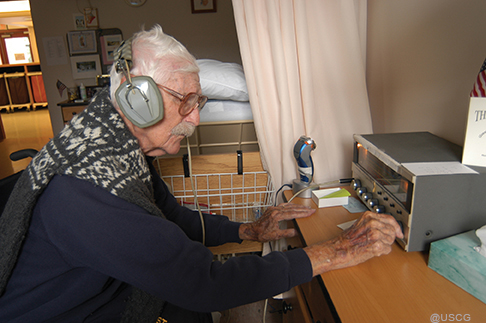The boats on which we sail are not the only things that have evolved demonic speeds. Modern offshore communications have developed right along with them. (published February 2015)
With spray flying up to the lower spreaders, we roared down the face of a 50-foot wave, surfing at speeds between 30 and 35 knots. The Southern Ocean wasn’t a particularly user-friendly place to race, but it was stunningly fast. The key to success was to unlock the secrets that the weather held in store for us so we could be prepared to take advantage of the upcoming conditions.
Fortunately, we had cutting edge communications gear onboard that allowed us to get weather information even as we raced a few hundred miles north of Antarctic pack ice. The weather forecasts were only available in Morse code, and we had a Morse code reader that automatically transcribed the code into letters and numbers, displaying the forecast as a streaming ticker tape image. This was cutting edge in January of 1982, but now seems primitive by modern standards. And communications continues to change drastically at an ever-increasing frequency, even as I write.
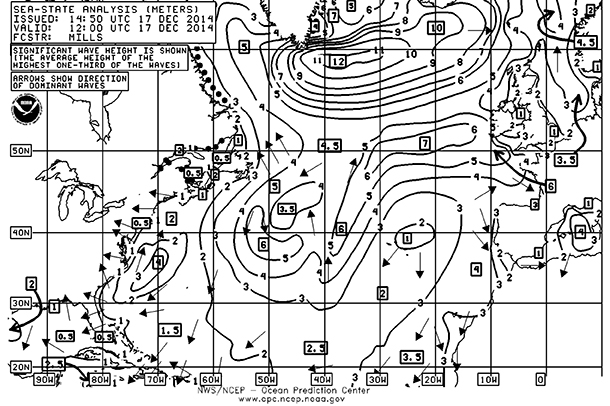
This means that with more choices laid out in front of us, getting information onboard has never been easier. But sometimes, those numerous choices can become almost overwhelming. What’s the fastest? Most reliable? Least expensive? How do the upfront costs compare to the usage costs? Can we still get weather information using older technologies? How about installation costs and time lines? There are so many things to consider that it really can become mind-boggling, and there isn’t enough space in this article to cover all of those issues. But we can at least get started with outlining some of the choices and point you towards more information.
Happily enough, Navtex and weather fax are still available (http://en.wikipedia.org/wiki/Navtex). For a low cost solution to getting weather maps onboard, I’ve even tested a small, battery operated portable Sony radio using a battery powered active antenna, and interfaced with my laptop and Weather for Windows software. I was able to receive clear weather maps produced by the Ocean Prediction Center and transmitted 3,000 miles away! Yes, you can get weather maps onboard your boat for a few hundred bucks plus a laptop (http://weather.noaa.gov/fax/marine.shtml). Of course there are more sophisticated, comprehensive and convenient ways to communicate, and they are somewhat more expensive. But they’re not prohibitively expensive any longer.
VHF and SSB have also come a long way. Whether you’re interested in voice communications or text, HF radio will help you get in touch with the world, and the Gordon West Radio School (http://www.gordonwestradioschool.com) will help you get in touch with your radio. If you’re interested in using your SSB, perhaps interfaced with a Pactor modem to send and receive email, you will want to explore services offered by Sailmail (http://www.sailmail.com).
Make no mistake; having an SSB onboard is still a critically valuable tool, whether you use it regularly or not. The ship that may someday come to your rescue doesn’t have your phone number, and you don’t have his, but you may be able to reach him on a ship to ship broadcast frequency and save yourself a great deal of anxiety. Learning how to use and maximizing the usefulness of that SSB radio still makes a lot of sense. Your life might depend on it.
Of course we’re all used to picking up the phone, dialing a number and getting in touch with almost anyone, almost anywhere in the world. And HF radios aren’t quite that simple. But satellite telephones are.
On the lower cost end of the spectrum, Iridium (http://www.iridium.com) and Globalstar (http://www.globalstar.com/) have approached satellite communications from slightly different perspectives. Iridium has a constellation of 66 satellites circling the globe providing worldwide coverage through their little portable handheld unit. Now, Iridium provides Wi-Fi connectivity through IridiumGO to your smartphone anywhere on the planet by creating a hotspot for up to five smartphones or tablets ( https://www.iridium.com//products/Iridium-GO.aspx?productCategoryID=1).
Globalstar uses a smaller number of satellites to provide partial coverage of the globe. (For a Globalstar coverage map, see: http://www.globalstar.com/en/index.php?cid=101&sidenav=85). A few years ago, Globalstar had rather significant problems establishing and maintaining calls due to the fact that several of their first generation satellites went out of service. Those seem to be behind them, however, and Globalstar has introduced a number of new devices and options including the ability to create remote hotspots and maintain connection via your smartphone while off the grid (http://www.globalstar.com/sat-fi/lander.php).
Utilizing Globalstar satellites, SPOT also continues to evolve into a more comprehensive, wide-ranging communications technology (http://www.findmespot.com/en/index.php?cid=120).
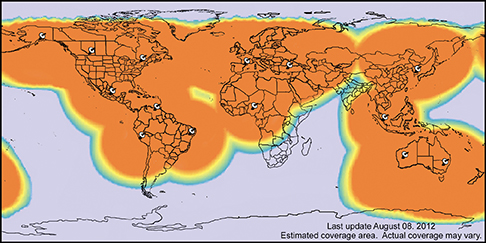
On numerous races and deliveries, I’ve had good luck with Iridium phones, whether to use their voice services or sending and receiving data. They’ve been quite reliable and relatively inexpensive. Whether using Globalstar or Iridium, you will need to go through a gateway, using a service provider. A sample of SPOT service plans can be found here: http://www.findmespot.com/en/index.php?cid=122). There are several, relatively common providers, including Ocens (http://www.ocens.com/Iridium-GO-P538.aspx) Stratos (http://www.stratosglobal.com), and many others. Ocens is quite common with mid-sized and larger vessels, I’ve found, and they provide a number of services, including weather and oceanographic data that works well with their proprietary email and weather display software. Ocens not only provides the airtime, they also can provide a wide range of hardware options from a variety of manufacturers.
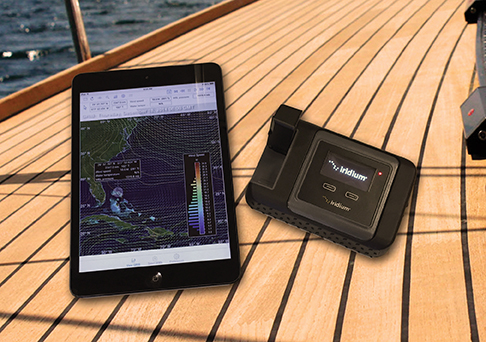
As many of us have discovered, accessing the Internet is not very practical using the relatively slow speeds of the earlier generation Iridium or Globalstar handheld units. Iridium now provides a range of hardware options, including the Openport system, which begins to reach broadband speeds, enabling access to the Internet. Similarly, INMARSAT’s Fleet Broadband also enables access to the Internet at comparable speeds. Fleet Broadband coverage does not quite cover the entire globe, but it does cover the most frequently crossed oceans of the world. (For coverage, see: http://www.inmarsat.com/about-us/our-satellites/our-coverage) Fleet Broadband units are manufactured by Thrane & Thrane, Wideye, KVH and JVC among others.
Of course, antenna size is a consideration when thinking about installing on a relatively small vessel. The Iridium Openport antenna is approximately 22-inches in diameter and nine inches tall, while the KVH TracPhone FB 150’s antenna is about 13.5 x 13-inches. Costs are certainly no less important (see: http://progressive.kvh.com/one/vseries.html). Overtime prices vary, although initial prices for the hardware ranged from about $4,000 to somewhat over $5,000, but keep in mind that while it used to cost almost $32 to send a low resolution photo via satellite communications, the cost is now down to around $7. Speeds are higher, and operating costs are lower. So it’s not all bad news.
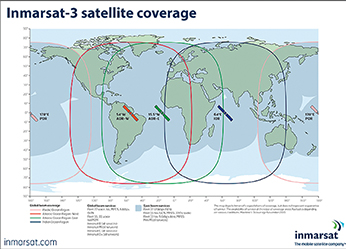
On the higher end of the communications market spectrum, KVH’s TracPhone V11ip and V7ip and mini-VSAT seem to reign supreme. And connection speeds on these units are fast enough to enable video teleconferencing! Rates will vary depending on the package that the user would like to purchase. They can be as low as $59 per month for 50 minutes of telephone time to as much as a thousand dollars or more per month for unlimited connection time, depending on the connection speed that is required.
Communications is changing quickly—too quickly to fully explain. We all know that we have come a long way from jungle drums or smoke signals over the past few hundred years. But the fact that in just a few decades our offshore communications have evolved from Morse code to high-speed video is certainly a stunning reality.
Bill Biewenga is a navigator, delivery skipper and weather router. His websites are www.weather4sailors.com and www.WxAdvantage.com. He can be contacted at billbiewenga@cox.net.

















